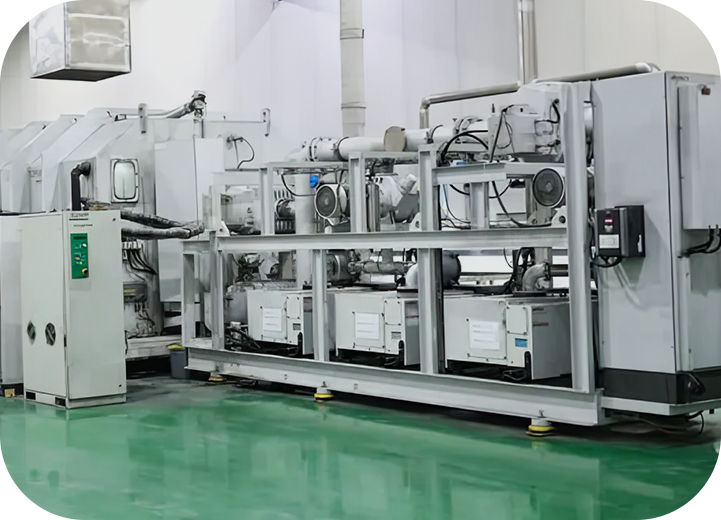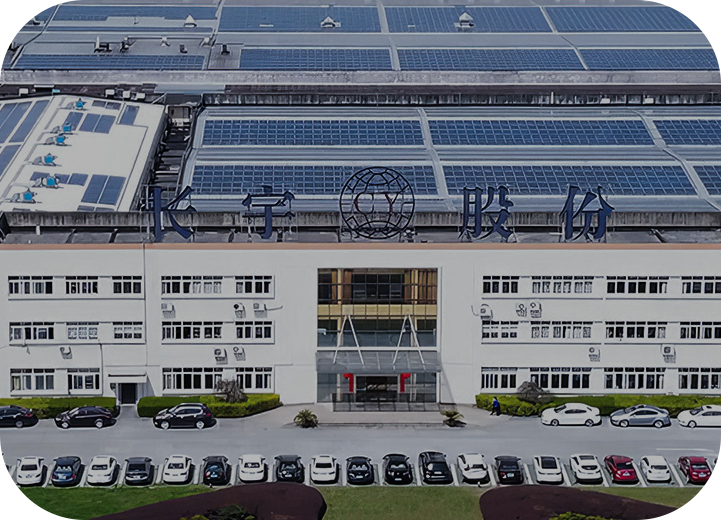Recommended product
Main Products
Understand Us
Zhejiang Changyu New Materials Co., Ltd.
Established in April 2000, Zhejiang Changyu New Materials Co., Ltd.,
is a professional manufacturer of high barrier metalized polyester films,
coated film, ALOx film in China. We keep stable cooperation with famous
enterprises like Amcor, Bemis, Zijiang.
We have about 350 employees and the factory covers an area of 40,000 square meters. Our main products include VMPET, VMCPP, VMBOPP, PVDC coated film, Acrylic coated film, ALOx PET film.
VIEW MORE
We have about 350 employees and the factory covers an area of 40,000 square meters. Our main products include VMPET, VMCPP, VMBOPP, PVDC coated film, Acrylic coated film, ALOx PET film.
Understand Us
Advanced Production Equipment
16 metallizing equipment and 5 coating equipment, our annual output is 100,000 MT various metallized film and 8,000 MT coated film. The introduction of alumina equipment and crucible metalizer from Germany are committed to the development of high-end products.
FACTORY

What Sets Us Apart
-
 CapacityOver 100,000MT
CapacityOver 100,000MT -
 Equipment16 metallizing +5 coating
Equipment16 metallizing +5 coating -
 Comprehensive productsInnovation products
Comprehensive productsInnovation products -
 Rich experience25 years of industry experience
Rich experience25 years of industry experience -
 Brand effectGood reputation
Brand effectGood reputation -
 Trends of the industryCooperation with well-known enterprises
Trends of the industryCooperation with well-known enterprises -
 Quality controlEnsure product quality
Quality controlEnsure product quality -
 Excellent serviceResponsible for customers
Excellent serviceResponsible for customers -
 Group advantageProvide professional guidance
Group advantageProvide professional guidance

News information
Update News
-
04 10,2025How can single-sided PVDC-coated PET film effectively block water vapor to protect moisture-sensitive products?PVDC is a polymer material with excellent barrier properties. The chlorine atoms in its molecular structure give the material extremely strong polarity and intermolecular forces, forming a dense molecular chain structure. When PVDC is evenly coated on one side of the PET substrate in the form of an extremely thin coating, this dense PVDC coating becomes an effective barrier to prevent water vapor penetration. The PET substrate itself has good mechanical strength and transparency. The combination with PVDC not only retains the advantages of PET, but also greatly improves the overall barrier performance, especially the barrier capacity for water vapor. The quality of water vapor barrier performance is usually measured by water vapor transmission rate (WVTR). The water vapor transmission rate of single-sided PVDC-coated PET film is extremely low, much lower than that of PET film not coated with PVDC, which means that it can effectively prevent water vapor from penetrating from the outside of the package to the inside, thereby maintaining a dry environment inside the package. Advantages of water vapor barrier propertiesExtend shelf life: For moisture-sensitive foods and medicines, the penetration of water vapor can cause increased product humidity, which can lead to problems such as mold, corruption or reduced efficacy. The water vapor barrier properties of single-sided PVDC-coated PET film can significantly reduce the humidity level in the package, thereby extending the shelf life of the product.Maintain product quality: In addition to extending the shelf life, single-sided PVDC-coated PET film can also effectively maintain the original quality and taste of the product. For example, for moisture-sensitive foods such as biscuits and candies, water vapor barrier properties can prevent the product from becoming soft, sticky or losing its brittleness due to moisture absorption; for medicines, it can prevent them from deteriorating or failing due to humidity changes.Reduce packaging costs: Because single-sided PVDC-coated PET film has excellent water vapor barrier properties, it can reduce the need for desiccant or dehumidification equipment, thereby reducing packaging costs. At the same time, due to its good mechanical properties and transparency, it can also reduce the thickness and weight of packaging materials, further reducing production costs. Performance in practical applicationsFood packaging: In the field of food packaging, single-sided PVDC-coated PET film is widely used in the packaging of moisture-sensitive foods such as biscuits, candies, cakes, meat products, and dairy products. Its water vapor barrier performance can keep the food dry and crispy, extend the shelf life, and reduce the quality degradation caused by the air permeability of the packaging material.Pharmaceutical packaging: For medicines that need to be stored for a long time and are sensitive to humidity, such as tablets, capsules, powders, etc., single-sided PVDC-coated PET film also performs well. Its water vapor barrier performance can protect the medicine from the influence of humidity and ensure the stability and safety of the medicine. Since the PVDC material itself has excellent chemical stability, it can also prevent chemical reactions between the medicine and the packaging material.Other applications: In addition to food and medicine, single-sided PVDC-coated PET film is also used in the packaging of electronic products, agricultural products and other fields. For example, in the packaging of electronic products, its water vapor barrier performance can prevent electronic components from being damaged by humidity changes; in the packaging of agricultural products, it can protect agricultural products such as seeds and pesticides from the influence of humidity to ensure their quality and effect. As consumers' requirements for product quality and safety continue to increase, as well as their awareness of environmental protection, the water vapor barrier performance of single-sided PVDC-coated PET film will face higher challenges. In the future, research in this field will focus more on the environmental friendliness, degradability, and compatibility with other packaging materials. In order to meet the needs of different fields and products, it is also necessary to develop customized products with specific water vapor transmission rate, air permeability, and barrier properties.

-
04 03,2025How does boiling PVDC coated BOPA film expand its application in food packaging?The unique performance of boiling PVDC coated BOPA film mainly comes from the perfect combination of its double-layer structure. As a substrate, BOPA film provides high strength and excellent barrier properties. The hydrogen bonding between nylon molecular chains makes BOPA film have excellent barrier effect on gases such as oxygen, nitrogen, and carbon dioxide, thereby effectively extending the shelf life of food. The PVDC coating further enhances the film's high temperature resistance and preservation ability. PVDC is a high barrier resin with excellent oxygen, moisture and gas barrier properties. When it is coated on BOPA film, it can form a dense protective layer that effectively prevents the external environment from invading the food in the package. PVDC coating can withstand high temperatures up to a certain temperature (such as 140°C) without deformation or damage. This feature enables boiling PVDC coated BOPA film to maintain the integrity and sealing of the package during high-temperature boiling. The application of boiling PVDC coated BOPA film in the food packaging industry is mainly concentrated in the field of food that requires high temperature treatment. These foods need to withstand high temperature and high pressure during processing, and traditional packaging materials often cannot meet this demand. Boiling PVDC coated BOPA film has become an ideal packaging choice for these foods with its excellent performance combination. Stewed food is a kind of food that needs to be cooked at high temperature for a long time. Its packaging materials need to be able to withstand high temperature and high pressure environment while maintaining the integrity and sealing of the packaging. Boiling PVDC coated BOPA film just meets this demand. Its high strength and high temperature resistance enable the packaging to maintain structural stability during high temperature stewing, while its excellent barrier properties effectively extend the shelf life of the food. Canned food is a kind of food that has been sterilized at high temperature. Its packaging materials need to be able to withstand the sterilization environment of high temperature and high pressure while maintaining the sealing and barrier properties of the packaging. Boiling PVDC coated BOPA film is also suitable for this field. Its PVDC coating can effectively prevent the external environment from invading the food in the package, while the high strength of the BOPA film ensures the integrity and stability of the package. In addition, the boiling PVDC coated BOPA film also has good transparency and glossiness, making the food in the package more tempting and delicious. This feature is particularly important in the food packaging industry because it can attract consumers' attention and improve the market competitiveness of products. In addition to the food packaging industry, boiled PVDC coated BOPA film is also widely used in the fields of medicine, electronic products, etc. In pharmaceutical packaging, its high strength and barrier properties can protect drugs from the external environment, while its high temperature resistance enables it to maintain the integrity and sealing of the packaging during high-temperature sterilization. In electronic product packaging, boiled PVDC coated BOPA film can also provide good protection to prevent electronic products from being damaged during transportation and storage. With the continuous improvement of consumers' requirements for food safety and preservation, and the growing demand for high-performance materials in the packaging industry, the market prospects of boiled PVDC coated BOPA film are very broad. Especially in the field of food packaging, its unique combination of properties makes it an ideal choice for foods that require high-temperature processing. However, boiled PVDC coated BOPA film also faces some challenges. For example, its production cost is relatively high, and advanced production technology and equipment are required. In addition, with the improvement of environmental awareness, consumers are paying more and more attention to the recyclability and degradability of packaging materials. Therefore, how to reduce production costs and improve environmental performance while maintaining performance advantages will be an important direction for the future development of boiled PVDC coated BOPA film. Boiled PVDC coated BOPA film has shown a wide range of application prospects in the food packaging industry with its unique performance combination. Especially in the field of food that requires high temperature treatment, such as stewed food, canned food, etc., it has become an ideal packaging choice. With the continuous advancement of technology and the continuous expansion of the market, boiled PVDC coated BOPA film is expected to play its unique advantages in more fields and bring more efficient, environmentally friendly and safe solutions to the packaging industry.

-
03 24,2025How does the heat-sealing technology of heat-sealable metalized BOPP film ensure the sealing of the package?The heat-sealing performance of heat-sealable metalized BOPP film is mainly achieved through two technologies: coating with heat-sealable resin glue and co-extrusion composite technology. Coating with heat-sealable resin glue is an important step in the manufacturing process of heat-sealable metalized BOPP film. This step usually involves coating a layer of heat-sealable resin glue, such as PVDC (polyvinylidene chloride) latex, EVA (ethylene-vinyl acetate copolymer) latex, etc. on the surface of the BOPP film. These resin glues remain stable at room temperature, but can soften and bond when heated, thereby achieving heat sealing of the film. During the coating process, the coating amount and uniformity of the resin glue need to be precisely controlled to ensure the strength and sealing of the heat-sealing layer. The coated film also needs to be dried to remove the solvent in the glue to avoid bubbles during the heat sealing process or affect the heat sealing effect. Coextrusion composite technology is to mix the heat-sealable resin with the BOPP raw material in the extrusion stage, and extrude it through the coextrusion die to form a BOPP film with a heat-seal layer. This method can achieve a close combination of the heat-seal layer and the BOPP film and improve the heat-seal strength. During the coextrusion composite process, the amount of heat-sealable resin added and the extrusion speed need to be precisely controlled to ensure the uniformity and stability of the heat-seal layer. The coextrusion die also needs to be designed and optimized to achieve a good combination of the heat-seal layer and the BOPP film. Through the application of heat-sealable resin glue or coextrusion composite technology, the heat-sealable metallized BOPP film achieves heat-seal performance, which has significant advantages in the packaging process:The heat-sealable metallized BOPP film's heat-seal performance makes it easy to seal during the packaging process. When heat-sealing on the packaging machine, the heat-seal layer of the film softens and bonds under heating to form a tight sealing structure. This sealing structure can effectively prevent product leakage and contamination, ensuring the quality and safety of the product. The introduction of heat-sealing technology not only improves the sealing of the packaging, but also greatly improves the packaging efficiency. Compared with traditional mechanical or adhesive sealing methods, heat sealing technology is faster, simpler and more reliable. At the same time, the heat sealing process can also be automated, further improving the efficiency and consistency of packaging production. The realization of heat sealing performance enables heat-sealable metallized BOPP film to be applied in more fields. For example, in food packaging, heat sealing technology can ensure that food is not contaminated and deteriorated during transportation and storage; in pharmaceutical packaging, heat sealing technology can keep pharmaceuticals dry and stable; in cosmetic packaging, heat sealing technology can protect cosmetics from external factors. In order to ensure that the heat sealing performance of heat-sealable metallized BOPP film meets packaging requirements, strict quality control is required:During the raw material procurement stage, BOPP raw materials and heat-sealable resins need to be strictly inspected and screened. Ensure that the quality of raw materials meets production requirements to avoid substandard heat sealing performance due to raw material problems. During the production process, the coating or co-extrusion process needs to be monitored in real time. By monitoring parameters such as coating amount, extrusion speed, and temperature, the uniformity and stability of the heat sealing layer are ensured. At the same time, sampling and testing of finished products is also required to verify whether the heat sealing performance meets the requirements. Before the finished product leaves the factory, a series of performance tests and evaluations are required. These include heat seal strength test, peel strength test, barrier performance test, etc. These tests can comprehensively evaluate the heat seal performance of heat sealable metallized BOPP film and its application effect in packaging. Heat sealable metallized BOPP film achieves heat seal performance by coating heat sealable resin glue or co-extrusion composite technology, which has significant advantages in the packaging process. It can not only easily achieve sealing and effectively prevent product leakage and contamination; it can also improve packaging efficiency and expand the scope of application. In order to ensure that the heat seal performance of heat sealable metallized BOPP film meets packaging requirements, strict quality control is required. Through raw material inspection, production process monitoring, performance testing and evaluation and other measures, it can ensure that the heat sealable metallized BOPP film plays the best effect in packaging.

-
03 20,2025How to ensure the precise control of the surface gloss of low heat sealing temperature metallized CPP film?The selection of surface layer raw materials is the key to ensure the gloss of low heat sealing temperature metallized CPP film. High-quality surface layer raw materials should have the following characteristics:Good coating adhesion: The molecular structure in the raw material should have good compatibility with the metal coating to ensure that the coating can be firmly attached to the surface of the film and is not easy to fall off or peel off.Excellent transparency: The raw material should have high transparency so that the metal coating can be clearly presented, thereby enhancing the overall visual effect of the product.Suitable melting temperature: The melting temperature of the raw material should match the heating temperature during the metallization process to ensure that the raw material can be fully softened during the metallization process to facilitate the deposition and bonding of metal atoms.Good weather resistance: The raw material should have a certain weather resistance to prevent the gloss from decreasing or the coating from falling off due to factors such as light and temperature during long-term storage or use.Based on the above characteristics, the surface layer raw materials are usually selected from specially formulated and treated polypropylene (PP) resins. These resins undergo fine molecular design and synthesis processes to ensure that they meet the various requirements of the metallization process. After selecting the appropriate surface material, it is also necessary to further improve its gloss through fine process treatment. It mainly includes the following aspects:Raw material pretreatment: Before the raw material enters the production line, it needs to be strictly pretreated, including removing impurities, adjusting the particle size, etc., to ensure the purity and uniformity of the raw material.Formula adjustment: According to the specific needs of the metallization process, the raw material formula is adjusted. For example, an appropriate amount of plasticizers, antioxidants and other additives can be added to improve the processing performance and weather resistance of the raw material.Melt extrusion: During the melt extrusion process, parameters such as extrusion temperature, pressure and speed need to be strictly controlled to ensure that the raw material can be fully melted and evenly distributed on the surface of the film. At the same time, attention should also be paid to the cleaning and maintenance of the extruder to prevent impurity contamination and affect the gloss.Cooling and shaping: The extruded film needs to be quickly cooled and shaped to fix its shape and gloss. The selection of parameters such as cooling speed and shaping pressure should be determined according to the characteristics of the raw materials and the specific needs of the metallization process. In order to ensure the precise control of the glossiness of the surface layer of low heat sealing temperature metallized CPP film, the following strategies need to be adopted:Raw material ratio optimization: Through experiments and practice, the raw material ratio is continuously optimized to find the best balance between coating adhesion and glossiness. This requires an in-depth understanding and accurate judgment of the performance of the raw materials.Precise control of processing parameters: In key processes such as melt extrusion and cooling and shaping, various processing parameters such as temperature, pressure, speed, etc. need to be precisely controlled. This can be achieved through advanced automatic control systems and sensors to ensure the stability and controllability of the processing process.Quality inspection and feedback: Set up quality inspection points on the production line to monitor and feedback key indicators such as film glossiness and coating adhesion in real time. Once quality problems are found, adjustments and improvements should be made immediately to ensure the quality of the final product.Continuous improvement and innovation: With the continuous development of the market and technology, it is necessary to continuously improve and innovate the production process and raw material formula of low heat sealing temperature metallized CPP film. This includes exploring new sources of raw materials, developing new additives and technologies, etc. to enhance product performance and competitiveness. As one of the important performance indicators of low heat sealing temperature metallized CPP film, its precise control is of great significance to improving the overall visual effect and attractiveness of the product. In the fields of food packaging and daily necessities packaging, films with bright and uniform gloss can attract consumers' attention and improve the quality and image of products. In addition, in the packaging of textiles, flowers, electronic components and other fields, low heat sealing temperature metallized CPP film with precisely controlled gloss also has broad application prospects.

-
03 14,2025How does vacuum aluminum plating technology give semi-metallized PET film excellent quality?As the core process for the preparation of semi-metallized PET film, the secret of vacuum aluminum plating technology lies in the physical evaporation principle under high vacuum environment. In a closed vacuum chamber, metallic aluminum is heated to the evaporation temperature and then escapes in the form of gaseous aluminum atoms. These atoms diffuse freely in the vacuum and finally deposit on the surface of the PET film to form an extremely thin and uniform aluminum layer. This process requires not only a high degree of vacuum to avoid contamination or scattering of aluminum atoms during the deposition process, but also precise control of parameters such as the distance, angle and deposition time between the evaporation source and the PET film to ensure the uniformity and thickness of the aluminum layer. The first major feature of semi-metallized PET film given by vacuum aluminum plating technology is the extremely thin and uniform aluminum layer formed on its surface. Although the thickness of this aluminum layer is only nanometers, it is enough to give the film a metallic luster, making it shine in the sun. More importantly, this aluminum layer also gives the film excellent reflective properties. Due to the high reflectivity of aluminum, the semi-metallized PET film can effectively reflect the incident light back to form a bright glossy effect. This reflective property not only enhances the visual beauty of the film, but also makes it widely used in reflective materials, optical films and other fields. In addition to metallic luster and reflective properties, another major feature of semi-metallized PET film given by vacuum aluminum plating technology is the strong bonding force between the aluminum layer and the PET film. The formation of this bonding force is due to the interaction between aluminum atoms and surface molecules of the PET film during the vacuum aluminum plating process. During the vacuum aluminum plating process, aluminum atoms hit the surface of the PET film at an extremely high speed, collide with the surface molecules and embed into them, forming a chemical bond. This chemical bonding not only enhances the bonding force between the aluminum layer and the PET film, but also makes the aluminum layer less likely to fall off or peel off when subjected to external forces. This strong bonding force provides a strong guarantee for the wide application of semi-metallized PET film in packaging materials, building materials and other fields. In order to further improve the quality of semi-metallized PET film, vacuum aluminum plating technology is also being continuously optimized and innovated. On the one hand, by improving the design of the evaporation source and the selection of materials, the evaporation efficiency and uniformity of aluminum atoms can be improved, thereby further improving the thickness and uniformity of the aluminum layer. On the other hand, by introducing advanced technologies such as ion bombardment and laser-assisted evaporation, the interaction between aluminum atoms and the surface molecules of PET film can be enhanced, and the bonding force between aluminum layer and PET film can be further improved. In addition, the performance and structure of aluminum layer can be optimized by adjusting the process parameters in vacuum aluminum plating, such as evaporation temperature, deposition time, vacuum degree, etc., to meet the diversified needs of semi-metallized PET film in different fields. Thanks to the exquisite application of vacuum aluminum plating technology, semi-metallized PET film has shown excellent quality and application value in many fields. In the field of packaging materials, semi-metallized PET film has become an ideal packaging material for high-end tobacco, alcohol, gift boxes and other products with its metallic luster and excellent barrier properties. In the field of reflective materials, semi-metallized PET film has become the first choice for reflective materials such as traffic signs and safety warning signs with its high reflectivity and good weather resistance. In the field of optical films, semi-metallized PET film has become an important component of optical films such as liquid crystal displays and touch screens with its high light transmittance and excellent reflective properties. In the field of building materials, semi-metallized PET film has become the preferred material for building materials such as solar collectors and thermal insulation windows with its good thermal insulation properties and beautiful appearance.

-
03 14,2025Zhejiang Changyu New Materials Co., Ltd. will appear again at CHINAPLAS 2025, booth number 20R61 (Hall 20)Recently, our company announced that it will once again participate in the 37th "CHINAPLAS International Rubber and Plastic Exhibition" to be held at Shenzhen International Convention and Exhibition Center (Bao'an) from April 15 to 18, 2025. This time, our booth is located at booth 20R61 in Hall 20. We look forward to working with industry colleagues from all over the world to join hands in the new chapter of industry development. With the theme of "Change, Collaboration, and Sustainability", this China Plastic Exhibition will bring together more than 4,000 international exhibitors, with a total exhibition area of 380,000 square meters, to fully display innovative rubber and plastic technology solutions. Our company will focus on the latest research and development results in environmental protection, intelligence and high-tech solutions in recent years in this Chinaplas packaging exhibition. The exhibits will cover a series of high-performance, environmentally friendly plastic and rubber materials, as well as the advanced processing technologies and equipment that match them. Through these exhibits, our company will show the industry its firm commitment and outstanding strength in promoting sustainable development, improving production efficiency and product quality. It is worth mentioning that our company has achieved fruitful results in previous CHINAPLAS 2023 exhibitions. Through the exhibition platform, we have not only successfully demonstrated the company's latest technologies and products, but also established long-term and stable cooperative relations with many domestic and foreign customers and partners. These cooperations have not only brought more business opportunities to our company, but also promoted the company's continuous progress in technological innovation and market expansion. During this Chinaplas film exhibition, our company will also actively participate in various activities during the exhibition, including technical seminars, business matching meetings, etc. Through these activities, our company will further understand the market demand and industry trends, discuss solutions with colleagues in the industry, and work together to promote the sustainable development of the rubber and plastics industry. CHINAPLAS 2025 International Rubber and Plastics Exhibition is about to kick off. Our company sincerely invites customers, partners and colleagues in the industry to visit booth 20R61 in Hall 20 for guidance.

- Quick Links
- Company Profile
- Company Culture
- Qualification
- FAQ
- Product
- ALOx Films
- VMPET
- VMCPP
- VMBOPP
- Coated Film
- Contact Us
- Tel: +86-13456263964
-
Phone : +86-0573-87783633
Phone : +86-0573-87780583 - E-mail : [email protected]
- Address: 6th Xinhe Road, Xieqiao Town, Haining City, Zhejiang Province, China
Copyright © Zhejiang Changyu New Materials Co., Ltd.



 English
English 












